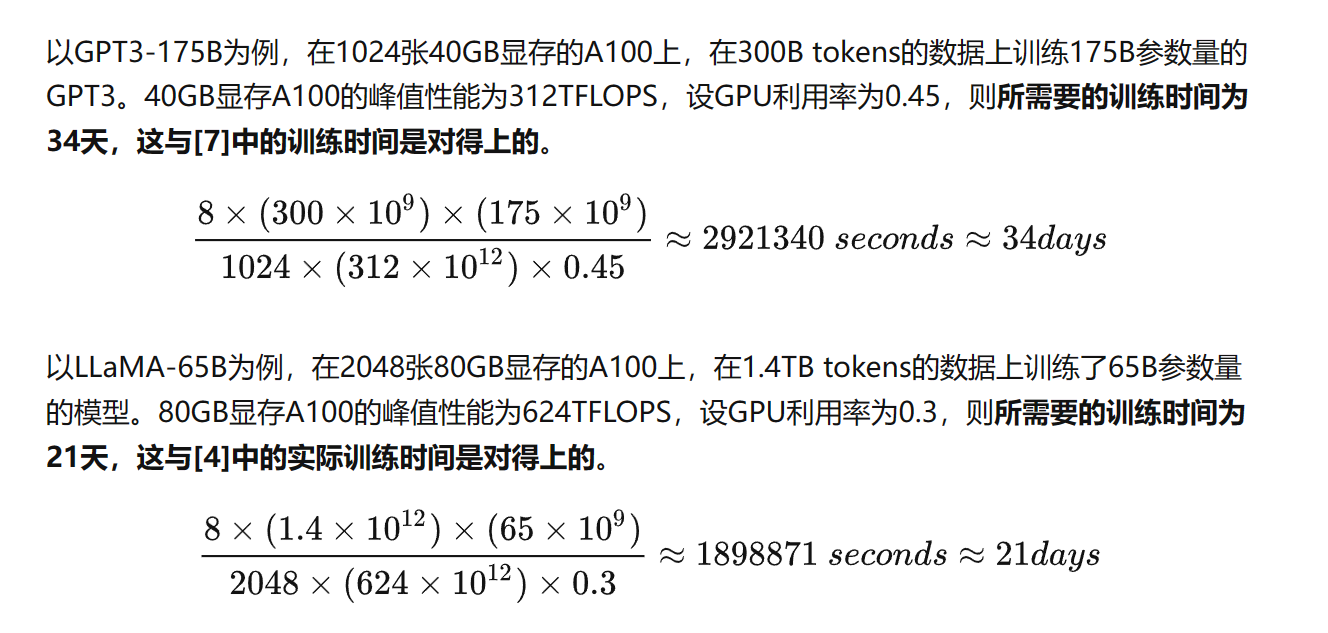返回列表
AICC大模型Cheat Sheet
2023-09-13
浏览量:6764
# 基础术语
* LLM:大语言模型(Large Language Model)
* AIGC:人工智能内容创作(AI Generate Content)
* AICC:人工智能计算中心(AI Computing Center),全国各地已建设(或在建)20+AICC
* B:Billions,十亿,通常用来表述模型参数规模
* DP:数据并行(Data Parallel),将模型复制多份,并行计算
* DDP:分布式数据并行(Distributed Data Parallel)
* PP:流水线并行(Pipeline Parallel),不同的NPU/GPU存放一个LLM的不同layer,流水线执行
* TP:张量并行(Tensor Parallel),不同的NPU/GPU存放一个LLM的相同Layer,共同完成一个超大张量的运算(通常在同一个节点上的NPU/GPU)
* MOE:混合专家系统(Mixture of Experts)
* ZeRO:Zero Redundancy Data Parallelism,一种HBM优化策略
# 进阶术语
* Ascend:昇腾芯片,华为自研芯片,对标NVIDIA芯片
* Ascend NPU:昇腾NPU芯片,目前主流的有32GB HBM和64GB HBM版本
* NPU:深度学习处理器(Neural Process Unit),对标GPU
* CANN:昇腾芯片使能层,对标NVIDIA CUDA编程接口
* MindSpore(MS):昇思框架,对标PyTorch/TensorFlow
* MindFormer(MindSpore Transformer):基于MindSpore(昇思框架)的Transformer大模型使能套件([MindSpore/mindformers](https://gitee.com/mindspore/mindformers))
* Euler:欧拉操作系统
* Kunpeng:鲲鹏CPU芯片,ARM架构,在人工智能业务里面通常无感知
* ACL(Ascend Computing Language):昇腾上的C++异构计算编程接口,python上亦有对应的pyACL接口
* BMS:裸金属服务器(Bare Metal Server),计算中心上的一种算力开放形式
* ModelArts:一种基于AICC/公有云的高度封装的AI服务
* 静态图模式:一种MindSpore的执行模式(与动态图模式对应),训练性能较高,但难以调试
* 动态图模式:一种MindSpore的执行模式(与静态图模式对应),易于调试,但训练性能较差
* AscendSpeed:DeepSpeed在Ascend芯片上的实现
* ModelZoo:昇腾社区上的一个页面([开发者主页-昇腾社区](https://www.hiascend.com/software/modelzoo)),提供目前Ascend上的一些已经实现或者适配的模型
* OBS:对象存储服务(Object Storage Service),用于存储训练过程中的代码、脚本及中间过程文件等
# 常用信息
## 模型参数量计算方式
* P:参数量
* l:模型层数
* h:隐藏层维度
P=12lh^2 (忽略Embedding层等信息)
例
| 实际参数量 | h | l | 12*lh^2 |
| ---------- | ---- | -- | -------------- |
| 6.7B | 4096 | 32 | 6,442,450,944 |
| 13B | 5120 | 40 | 12,582,912,000 |
| 32.5B | 6656 | 60 | 31,897,681,920 |
| 65B | 8192 | 80 | 64,424,509,440 |
## 模型文件大小(不含优化器状态)计算方式
* S:模型大小(单位为GB)
* P:模型参数量(单位为B)
S=2P
例如,13B参数模型大小约为26GB
## 推理模型大小计算方式
同模型文件大小计算方式,S=2P
## 训练模型大小(含优化器状态,显存HBM占用)计算方式
* S\_train:训练模型占用显存,单位为GB
* P:模型参数量(单位为B)
S\_train=20P
例如,13B参数模型训练占用HBM约为260GB
## 中间激活值大小计算方式
除了可训练参数及可训练参数相关的梯度、优化器状态以外(这部分参数的大小只和模型有关),激活(activation)占据了大量现存,激活指的是训练过程中得到的,需要在反向传播过程中使用的各张量(可以通过ZeRO方法优化activation这部分HBM占用),如Attention结构中Softmax的结果等。
对于l层transformer模型,中间激活层占用的现存可以近似为l\*(34bsh+5bs^2\*a),其中b表示batchsize,s表示sequence length,a表示注意力头数,不难发现,激活占用的HBM与b和s强相关。
以GPT3为例(s为2048),按照上面公式计算,175B权重约为350GB,训练时占用HBM为3.5TB,当b=1时,激活占用275GB,当b=64时,激活占用达到了恐怖的17.6TB,是模型参数的50倍。
## 训练时间计算方式
* T:训练时间
* n_token:token数量
* P:模型参数量
* n_GPU:NPU/GPU数量
* p_GPU:NPU/GPU峰值算力(FP16/BF16)
* usage:GPU利用率(在百卡以上集群,利用率约为30%~50%)
T=8 \* n_token \* P/(n_GPU \* p_GPU \* usage)
这里直接引用原始文章中对于GPT和LLaMA训练过程的分析

PS:
这里的Reference[4]和Reference[7]分别是
Touvron H, Lavril T, Izacard G, et al. Llama: Open and efficient foundation language models[J]. arXiv preprint arXiv:2302.13971, 2023.
Narayanan D, Shoeybi M, Casper J, et al. Efficient large-scale language model training on gpu clusters using megatron-lm[C]//Proceedings of the International Conference for High Performance Computing, Networking, Storage and Analysis. 2021: 1-15.
## 3D并行计算公式
```
```
num_NPUs = data_parallel_size * pipeline_parallel_size * tensor_parallel_size
```
## global_batch_size VS micro_batch_size
```
global_batch_size = micro_batch_size * data_parallel_size * gradient_accumulation_steps
```
gradient_accumulation_steps:累积forward+backward的次数以执行一次optimizer(the number of forward+backward before you step the optimizer)。当gradient_accumulation_steps=1时,有global_batch_size = micro_batch_size * data_parallel_size
## 吞吐率samples_per_second_per_piece(单位samples/s/p)
```
batch_size = micro_batch_size * num_micro_batches * data_parallel_size
samples_per_second = batch_size / elapsed_time_per_batch
samples_per_second_per_piece = samples_per_second / num_NPUs
```
## 吞吐率tokens_per_second_per_piece (单位tokens/s/p)
```
tokens_per_second_per_piece = samples_per_second_per_piece * sequence_length
```
## 浮点操作数TFLOPs_per_second(单位TFLOPs/s)
这里采用AscendSpeed仓提供的计算方式(reference: ascendspeed/utils.py/throughput_calculator),TFLOPs_per_second可以较好的表示在整个集群上每秒发生的计算数量(单位是TFLOPS),从而根据整体GPU的算力规模计算算力的使用率
```
flops_per_iteration = (24 * checkpoint_activations_factor * batch_size * seq_len * num_layers * (hidden_size**2)) * (1. + (seq_len / (6. * hidden_size)) + (vocab_size / (16. * num_layers * hidden_size)))
TFLOPs_per_second = flops_per_iteration / (elapsed_time_per_iter * args.world_size * (10**12))
```
* checkpoint_activations_factor: 参考[链接](https://docs.aws.amazon.com/sagemaker/latest/dg/model-parallel-extended-features-pytorch-activation-checkpointing.html),checkpoint_activations技术本质上是一种用计算换空间(HBM)的方法,如启用则在上面公式将此参数设置为4,如不启动则为3。
# 参考链接
[[S12]AICC大模型Cheat Sheet](https://zhuanlan.zhihu.com/p/656105169)
[基本介绍 - MindSpore master documentation](https://www.mindspore.cn/tutorials/zh-CN/r2.1/beginner/introduction.html)
[LLM Parameter Counting | kipply's blog](https://kipp.ly/transformer-param-count/)
[回旋托马斯x:分析transformer模型的参数量、计算量、中间激活、KV cache](https://zhuanlan.zhihu.com/p/624740065)
[JMXGODLZ:LLM训练指南(二):模型参数、计算量、显存、计算时间计算](https://zhuanlan.zhihu.com/p/639872915)
```
